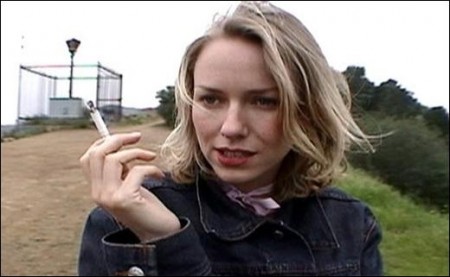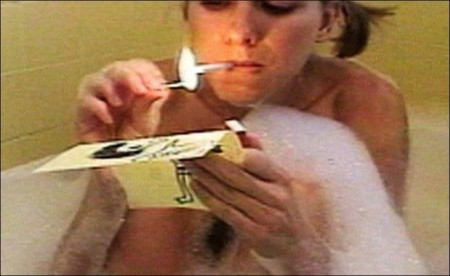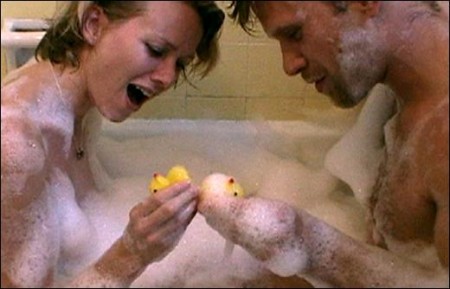Ellie Parker (Naomi Watts) races around town from one audition to another, changing make-up, clothes and personality as she speeds along, barely attending to her whirlwind life as she strives to get cast in a movie. And her best friend Sam (Rebecca Rigg), her boyfriend Justin(Mark Pellegrino) and her new fling Chris (Scott Coffey) just don’t seem to help. As Ellie considers giving up after losing faith in the craft, her manager Dennis (Chevy Chase) doesn’t exactly talk her out of it. One last insane audition for Ellie, and she’s back in the game… or is she?
About the Production
Five years ago, actor and director Scott Coffey took a small consumer-grade (purchased from Best Buy with a credit card) one-chip digital video camera and made a 16-minute film about a young actress struggling with identity in Los Angeles, shape-shifting from one character to another as she hurtles through the Los Angeles freeway system from one audition to another. Coffey and Naomi Watts shot for three days and the resulting short film ended up in the Short Program of the 2001 Sundance Film Festival.
Coffey “wanted to capture the fragmentation of this giant metropolis that I was living in. I always wanted to capture the bizarre existence most people experience in LA, living in their cars, alienated from each other in their cubes of steel. Also, the main character being an actress functions as a metaphor for modern living.”
With these themes in mind, the feature was shot over four years, in between jobs that Coffey had writing screenplays, and Watts shooting many movies and becoming a leading actress that she is known as today. Coffey shot the film on digital video because he “felt that DV captured the glaring, sometimes punishing light of Los Angeles perfectly. Also, DV expresses fragmentation better than any other way of filmmaking. It’s a pleasure to be so close with the actors, to be on their laps, in their faces.
Shooting on a consumer hand-held camera heightens the immediacy and intimacy of the piece. I liked to think of the camera as an extension of the Ellie’s nervous system. Audiences are familiar with the DV aesthetic, from reality television, so it was fun to play with this form. That said, nearly everything in “Ellie” was scripted and me and Naomi rehearsed quite a bit.”
Coffey says the style and visuals were very deliberate, even though they appear to be accidental. He says he “love[s] this seeming contradiction.” Watts recalls, “this was of making films is dearest to me because Scott and I could capture the intimacy of the filmmaking process like no other kind of filmmaking can do. It’s really a kind of freedom that most actors have never experienced. I felt really safe with Scott he is one of the best actor’s directors I’ve ever worked with. He was able to challenge me in a really inspiring way”
Coffey recalls, “It was kind of scary to see my hand-made movie go to such a huge festival like Sundance because the film was made in an opposite way than festivals like that are becoming, so the film has to be protected like a newborn doe. It was just me and my editor, and Naomi and a few other actors on shooting days, and now, thousands of people will be judging it, analyzing it.” This is different with “Ellie Parker” than for most directors, because it’s so close to Coffey. There was no corporation, not one financier, not one producer, no wardrobe, no props – during the shooting, 99% of the time, it was just a crew of one — Coffey.
“So it’s fragile – not made of steel and timber and rivets like most Hollywood features; it’s made of rice paper, balsa wood, paper mache, scotch tape and spit. It was made with human hands – there are no machines under the surface – and I left the film so that the viewer could see the hems still, so the viewer can feel Naomi and I there on the that day, our relationship, how much we trust each other, and how much we cared about what we were doing.” Watts, becoming famous because good reviews at Cannes, always went back to the project for these specific reasons. “It’s art with Scott and I were working together. Not once did we think about film festivals and money and distribution; we worked together purely for art’s sake.”
One of the strangest occurrences to happen during the making of this film was Watts becoming a huge movie star, Coffey recalls, “when before she was just the star of my short film. She always worked as an actress and she was never starving, but it was scary and thrilling at the same time to see her rocket to fame and million-dollar paychecks. I’ve seen fame happen to people before, but in this case, it was faster and more insane than I’d thought possible.”
Though there are obvious benefits and downsides to Watts becoming a “star” during this several-year-long process, Coffey says, “what happened to Naomi was good for my film, but I know that it could be dangerous, too. She could have just stopped shooting and it was definitely harder to find free days. And movie stars have a way of eclipsing their projects — whether they intend to or not – but luckily, Sundance and the independent film community is great at re-focusing the light back on the director. I can’t say there’s not a part of me who wishes that people had seen Naomi in my film first (many did, with the shorts, but not a lot), because I think she’s funnier and more poignant in “Ellie Parker” than she’s ever been before.” Watts agrees, saying, “I love the chance to be goofy and funny in “Ellie Parker” because this was the first time most people ever saw this side of me, and it’s a side I really cherish.”
“Ellie Parker” has taken on many, many incarnations since it began as a 16-minute short film that Coffey and Watts shot in two afternoons. After the short in 2001, the project evolved into a cable series for Showtime and HBO that turned out not to be, but Coffey is thankful “because that would have made the feature impossible.” The final incarnation of the project captures what Watts says is Coffey’s “original vision to make our project into a feature-length film.” Just a few days after finishing a rough cut, it was accepted into dramatic competition at the 2005 Sundance Film Festival, so as Coffey remembers, makes “all the failures, and all the potential lawsuits were worth it… in retrospect.”
Coffey recalls, “a lot happened in my life during the shooting including two loved ones – his mother, Gaye Pope (the former assistant to David Lynch), and one of his best friends and supporters, Jennifer Syme (who plays a casting director and Ellie’s boyfriend’s mistress), died. So, the film, in addition to exorcising demons from an acting career, bookends a long and good period in Coffey’s life bookends a period of Watts’ life also.
Director’s Notes
In Ellie Parker, I wanted to depict a type of contemporary life in Los Angeles through the portrait of a young woman’s struggle for personal and creative integrity. By making her an actress, I was able to play with all the contradictions and absurdities of modern life. In many ways, this seemed to serve as an apt metaphor for modern American life.
There are times, especially during pilot season, when an actor has to go to three or four auditions in a single day – read for a family sit-com, race across town to audition for a medical drama, and then, in minutes, get back to the valley for a new cop show. Sometimes, this means taking several outfits, literally using your car as a dressing room. For an actress, matters are further complicated by having to redo hair and make up. Imagine dealing with money, worries, and your personal life on top of this. Even though I wanted Ellie Parker to be personal and not polemic, I brought many of my own experiences of being an actor and living in Los Angles to the film.
The first short of Ellie Parker (the first 17 minutes) had its world premiere at the 2001 Sundance Film Festival and has since played at The Aspen Shorts Fest, Phat Shorts in New York and The Method Fest, where Naomi won best actress for her performance. We were so happy with the first short film and have received such a great response that we made three more shorts of Ellie Parker, exploring her character more deeply.
Ellie Parker was the perfect story to shoot on digital video. I used a tiny Sony Mini DV camera that was perfect to get the kind of voyeuristic feeling I wanted. It was especially great in the car sequences where I could get right in Naomi’s face. She was really driving and putting on make up and changing at the same time she was giving a totally funny and emotionally riveting performance.
I met Naomi Watts five years ago while we were both acting on a movie called Tank Girl. Since then, we worked together again on David Lynch’s Mulholland Drive and became great friends. When I had the idea for Ellie Parker, she was the first person I thought of. We could have never made as naked and as intimate of a piece if we didn’t trust each other as much as we do. It was difficult not having a crew and having to do literally everything myself, but I think that is part of what makes this project unique and original and it’s rawness helps underline the voyeuristic cinema verite vibe of the project. – Scott Coffey
Interview with Naomi Watts
The actress Naomi Watts has become a major star but long before she hit the big time she became involved in ‘Ellie Parker’ well before she was a Hollywood name. It’s a film about acting, set in LA, and it was given its world premiere at Sundance. Laura Metzger went to see it, and talked to Naomi Watts, who plays the title role.
Ellie Parker is a struggling actress, conflicted about her career, her love life and her future in general. The character was created by Scott Coffey, another actor and a friend of Watts’.
Naomi Watts: “Scott and I worked together as actors twice, once in ‘Tank Girl’ and then again in ‘Mulholland Drive’. He was an actor back then, and he talked about this idea he’d been working on and that he would love to show an actress going from one audition to another and see her changes happen.”
Parts of the film are being screened at Sundance for the second time. That’s because ‘Ellie Parker’ was entered as a short film at the 2001 Sundance Film Festival, when Watts was still an unknown. But her anonymity didn’t last much longer and by the time Coffey decided to make ‘Ellie Parker’ into a feature length film Watts was a big star.
Scott Coffey: “The film sort of evolved into what it is now. And that’s kind of cool, because it sort of corresponds with her struggle as a person, the way the film sort of grew.”
Even before Sundance began there was a bit of buzz around ‘Ellie Parker’, but perhaps that’s because the film’s inclusion in the festival line-up meant Naomi Watts, an A-list star, might grace Park City with her presence.
Watts agrees her celebrity status helped promote the film, which by all accounts is a very low budget, indie endeavour.
Naomi Watts: “We made this film when we were both struggling, and since then I’ve made a number of films, some of which have had great commercial success. And there is no question that that can help.
We made this film because we loved doing what we were doing and we had something to say and we wanted to share. So anything we can do, using that, is the point, because it’s about sharing it, we want to show it to everyone.”
These production notes provided by Strand Releasing.
Ellie Parker
Starring: Naomi Watts, Chevy Chase, Scott Coffey, Mark Pellegrino, Fanshen Cox
Directed by: Scott Coffey
Screenplay by: Scott Coffey
Release Date: November 11, 2005
MPAA Rating: PG for fantasy action and peril, and some language.
Studio: Strand Releasing
Box Office Totals
Domestic: $34,410 (75.3%)
Foreign: $11,316 (24.7%)
Total: $45,726 (Worldwide)



